Investigation of Flow Characteristics in Air Flow Measurement Devices
VerifiedAdded on 2019/10/16
|10
|2009
|375
Practical Assignment
AI Summary
This assignment investigates the flow characteristics of various air flow measuring and controlling devices using a controlled delivery air blower. The experiment studies orifice plates, nozzles, Venturi tubes, Pitot tubes, and Iris valves, measuring the air flow rate and corresponding pressure drop across each device. The procedure involves bolting the devices between PVC pipe sections, connecting pressure tapping points to manometers, and measuring air velocity with an anemometer. Results are presented for each device, including tables of potentiometer settings, manometer readings, calculated pressure drops, and velocities. Sample calculations are provided for converting water column height to Pascal units and determining flow rates. The discussion section analyzes the characteristics of each device, and the conclusion confirms the theoretical equations. The assignment also includes questions on the merits of each device, flow rate calculations, and the impact of Pitot tube diameter and pipe bends on pressure drop. The assignment aims to verify theoretical equations and analyze the performance of these devices in air flow measurement.
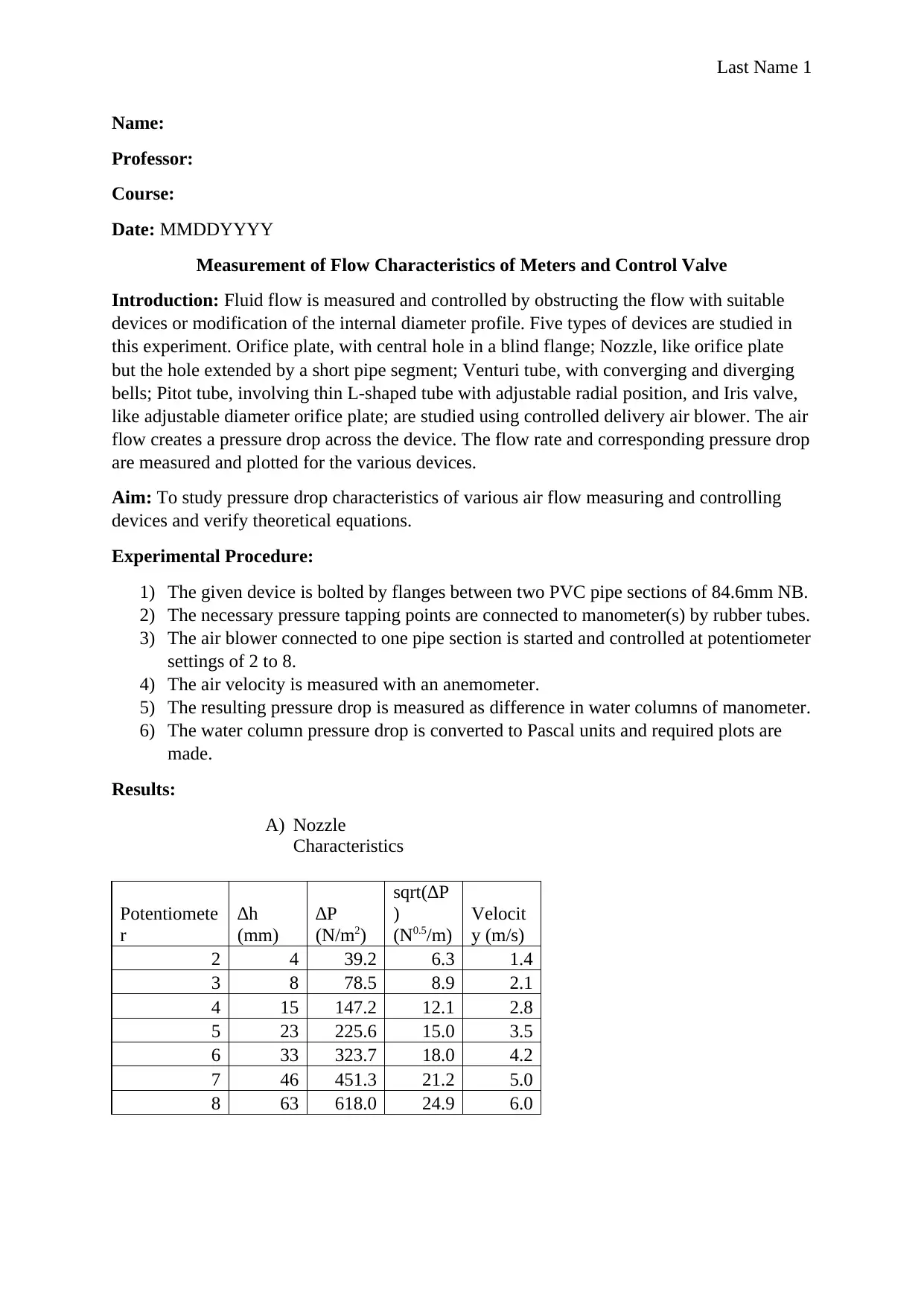
Last Name 1
Name:
Professor:
Course:
Date: MMDDYYYY
Measurement of Flow Characteristics of Meters and Control Valve
Introduction: Fluid flow is measured and controlled by obstructing the flow with suitable
devices or modification of the internal diameter profile. Five types of devices are studied in
this experiment. Orifice plate, with central hole in a blind flange; Nozzle, like orifice plate
but the hole extended by a short pipe segment; Venturi tube, with converging and diverging
bells; Pitot tube, involving thin L-shaped tube with adjustable radial position, and Iris valve,
like adjustable diameter orifice plate; are studied using controlled delivery air blower. The air
flow creates a pressure drop across the device. The flow rate and corresponding pressure drop
are measured and plotted for the various devices.
Aim: To study pressure drop characteristics of various air flow measuring and controlling
devices and verify theoretical equations.
Experimental Procedure:
1) The given device is bolted by flanges between two PVC pipe sections of 84.6mm NB.
2) The necessary pressure tapping points are connected to manometer(s) by rubber tubes.
3) The air blower connected to one pipe section is started and controlled at potentiometer
settings of 2 to 8.
4) The air velocity is measured with an anemometer.
5) The resulting pressure drop is measured as difference in water columns of manometer.
6) The water column pressure drop is converted to Pascal units and required plots are
made.
Results:
A) Nozzle
Characteristics
Potentiomete
r
∆h
(mm)
∆P
(N/m2)
sqrt(∆P
)
(N0.5/m)
Velocit
y (m/s)
2 4 39.2 6.3 1.4
3 8 78.5 8.9 2.1
4 15 147.2 12.1 2.8
5 23 225.6 15.0 3.5
6 33 323.7 18.0 4.2
7 46 451.3 21.2 5.0
8 63 618.0 24.9 6.0
Name:
Professor:
Course:
Date: MMDDYYYY
Measurement of Flow Characteristics of Meters and Control Valve
Introduction: Fluid flow is measured and controlled by obstructing the flow with suitable
devices or modification of the internal diameter profile. Five types of devices are studied in
this experiment. Orifice plate, with central hole in a blind flange; Nozzle, like orifice plate
but the hole extended by a short pipe segment; Venturi tube, with converging and diverging
bells; Pitot tube, involving thin L-shaped tube with adjustable radial position, and Iris valve,
like adjustable diameter orifice plate; are studied using controlled delivery air blower. The air
flow creates a pressure drop across the device. The flow rate and corresponding pressure drop
are measured and plotted for the various devices.
Aim: To study pressure drop characteristics of various air flow measuring and controlling
devices and verify theoretical equations.
Experimental Procedure:
1) The given device is bolted by flanges between two PVC pipe sections of 84.6mm NB.
2) The necessary pressure tapping points are connected to manometer(s) by rubber tubes.
3) The air blower connected to one pipe section is started and controlled at potentiometer
settings of 2 to 8.
4) The air velocity is measured with an anemometer.
5) The resulting pressure drop is measured as difference in water columns of manometer.
6) The water column pressure drop is converted to Pascal units and required plots are
made.
Results:
A) Nozzle
Characteristics
Potentiomete
r
∆h
(mm)
∆P
(N/m2)
sqrt(∆P
)
(N0.5/m)
Velocit
y (m/s)
2 4 39.2 6.3 1.4
3 8 78.5 8.9 2.1
4 15 147.2 12.1 2.8
5 23 225.6 15.0 3.5
6 33 323.7 18.0 4.2
7 46 451.3 21.2 5.0
8 63 618.0 24.9 6.0
Paraphrase This Document
Need a fresh take? Get an instant paraphrase of this document with our AI Paraphraser
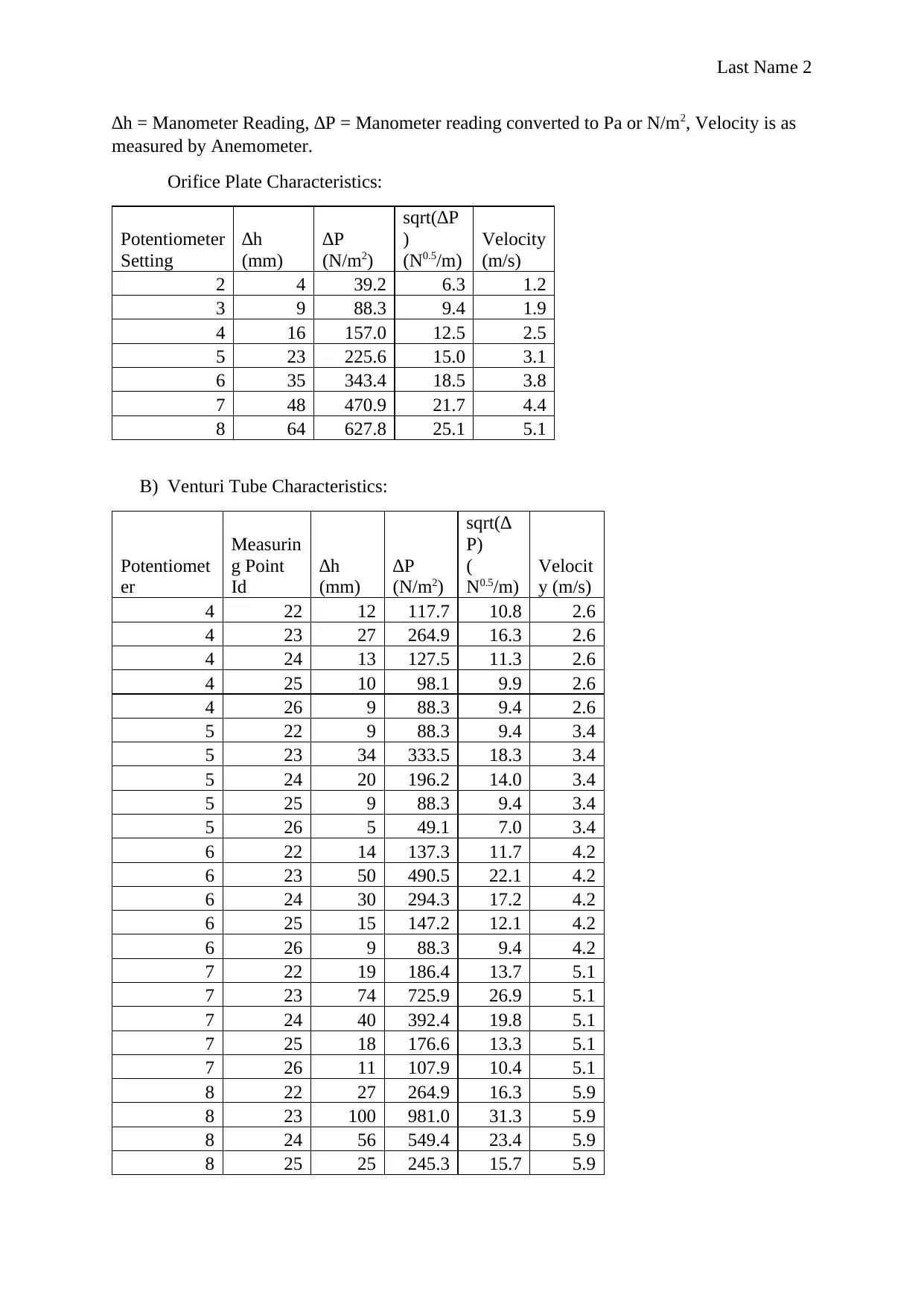
Last Name 2
∆h = Manometer Reading, ∆P = Manometer reading converted to Pa or N/m2, Velocity is as
measured by Anemometer.
Orifice Plate Characteristics:
Potentiometer
Setting
∆h
(mm)
∆P
(N/m2)
sqrt(∆P
)
(N0.5/m)
Velocity
(m/s)
2 4 39.2 6.3 1.2
3 9 88.3 9.4 1.9
4 16 157.0 12.5 2.5
5 23 225.6 15.0 3.1
6 35 343.4 18.5 3.8
7 48 470.9 21.7 4.4
8 64 627.8 25.1 5.1
B) Venturi Tube Characteristics:
Potentiomet
er
Measurin
g Point
Id
∆h
(mm)
∆P
(N/m2)
sqrt(∆
P)
(
N0.5/m)
Velocit
y (m/s)
4 22 12 117.7 10.8 2.6
4 23 27 264.9 16.3 2.6
4 24 13 127.5 11.3 2.6
4 25 10 98.1 9.9 2.6
4 26 9 88.3 9.4 2.6
5 22 9 88.3 9.4 3.4
5 23 34 333.5 18.3 3.4
5 24 20 196.2 14.0 3.4
5 25 9 88.3 9.4 3.4
5 26 5 49.1 7.0 3.4
6 22 14 137.3 11.7 4.2
6 23 50 490.5 22.1 4.2
6 24 30 294.3 17.2 4.2
6 25 15 147.2 12.1 4.2
6 26 9 88.3 9.4 4.2
7 22 19 186.4 13.7 5.1
7 23 74 725.9 26.9 5.1
7 24 40 392.4 19.8 5.1
7 25 18 176.6 13.3 5.1
7 26 11 107.9 10.4 5.1
8 22 27 264.9 16.3 5.9
8 23 100 981.0 31.3 5.9
8 24 56 549.4 23.4 5.9
8 25 25 245.3 15.7 5.9
∆h = Manometer Reading, ∆P = Manometer reading converted to Pa or N/m2, Velocity is as
measured by Anemometer.
Orifice Plate Characteristics:
Potentiometer
Setting
∆h
(mm)
∆P
(N/m2)
sqrt(∆P
)
(N0.5/m)
Velocity
(m/s)
2 4 39.2 6.3 1.2
3 9 88.3 9.4 1.9
4 16 157.0 12.5 2.5
5 23 225.6 15.0 3.1
6 35 343.4 18.5 3.8
7 48 470.9 21.7 4.4
8 64 627.8 25.1 5.1
B) Venturi Tube Characteristics:
Potentiomet
er
Measurin
g Point
Id
∆h
(mm)
∆P
(N/m2)
sqrt(∆
P)
(
N0.5/m)
Velocit
y (m/s)
4 22 12 117.7 10.8 2.6
4 23 27 264.9 16.3 2.6
4 24 13 127.5 11.3 2.6
4 25 10 98.1 9.9 2.6
4 26 9 88.3 9.4 2.6
5 22 9 88.3 9.4 3.4
5 23 34 333.5 18.3 3.4
5 24 20 196.2 14.0 3.4
5 25 9 88.3 9.4 3.4
5 26 5 49.1 7.0 3.4
6 22 14 137.3 11.7 4.2
6 23 50 490.5 22.1 4.2
6 24 30 294.3 17.2 4.2
6 25 15 147.2 12.1 4.2
6 26 9 88.3 9.4 4.2
7 22 19 186.4 13.7 5.1
7 23 74 725.9 26.9 5.1
7 24 40 392.4 19.8 5.1
7 25 18 176.6 13.3 5.1
7 26 11 107.9 10.4 5.1
8 22 27 264.9 16.3 5.9
8 23 100 981.0 31.3 5.9
8 24 56 549.4 23.4 5.9
8 25 25 245.3 15.7 5.9
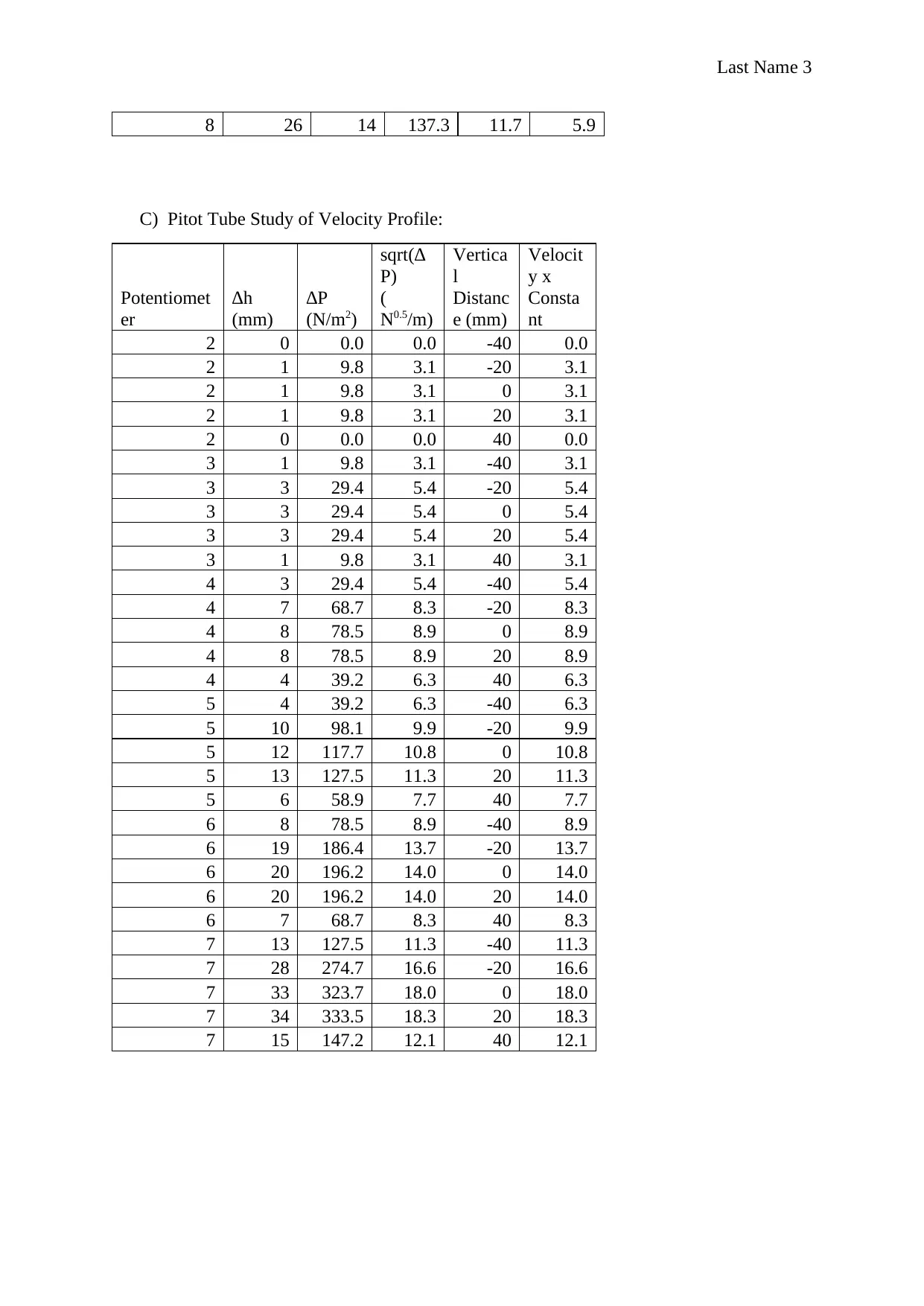
Last Name 3
8 26 14 137.3 11.7 5.9
C) Pitot Tube Study of Velocity Profile:
Potentiomet
er
∆h
(mm)
∆P
(N/m2)
sqrt(∆
P)
(
N0.5/m)
Vertica
l
Distanc
e (mm)
Velocit
y x
Consta
nt
2 0 0.0 0.0 -40 0.0
2 1 9.8 3.1 -20 3.1
2 1 9.8 3.1 0 3.1
2 1 9.8 3.1 20 3.1
2 0 0.0 0.0 40 0.0
3 1 9.8 3.1 -40 3.1
3 3 29.4 5.4 -20 5.4
3 3 29.4 5.4 0 5.4
3 3 29.4 5.4 20 5.4
3 1 9.8 3.1 40 3.1
4 3 29.4 5.4 -40 5.4
4 7 68.7 8.3 -20 8.3
4 8 78.5 8.9 0 8.9
4 8 78.5 8.9 20 8.9
4 4 39.2 6.3 40 6.3
5 4 39.2 6.3 -40 6.3
5 10 98.1 9.9 -20 9.9
5 12 117.7 10.8 0 10.8
5 13 127.5 11.3 20 11.3
5 6 58.9 7.7 40 7.7
6 8 78.5 8.9 -40 8.9
6 19 186.4 13.7 -20 13.7
6 20 196.2 14.0 0 14.0
6 20 196.2 14.0 20 14.0
6 7 68.7 8.3 40 8.3
7 13 127.5 11.3 -40 11.3
7 28 274.7 16.6 -20 16.6
7 33 323.7 18.0 0 18.0
7 34 333.5 18.3 20 18.3
7 15 147.2 12.1 40 12.1
8 26 14 137.3 11.7 5.9
C) Pitot Tube Study of Velocity Profile:
Potentiomet
er
∆h
(mm)
∆P
(N/m2)
sqrt(∆
P)
(
N0.5/m)
Vertica
l
Distanc
e (mm)
Velocit
y x
Consta
nt
2 0 0.0 0.0 -40 0.0
2 1 9.8 3.1 -20 3.1
2 1 9.8 3.1 0 3.1
2 1 9.8 3.1 20 3.1
2 0 0.0 0.0 40 0.0
3 1 9.8 3.1 -40 3.1
3 3 29.4 5.4 -20 5.4
3 3 29.4 5.4 0 5.4
3 3 29.4 5.4 20 5.4
3 1 9.8 3.1 40 3.1
4 3 29.4 5.4 -40 5.4
4 7 68.7 8.3 -20 8.3
4 8 78.5 8.9 0 8.9
4 8 78.5 8.9 20 8.9
4 4 39.2 6.3 40 6.3
5 4 39.2 6.3 -40 6.3
5 10 98.1 9.9 -20 9.9
5 12 117.7 10.8 0 10.8
5 13 127.5 11.3 20 11.3
5 6 58.9 7.7 40 7.7
6 8 78.5 8.9 -40 8.9
6 19 186.4 13.7 -20 13.7
6 20 196.2 14.0 0 14.0
6 20 196.2 14.0 20 14.0
6 7 68.7 8.3 40 8.3
7 13 127.5 11.3 -40 11.3
7 28 274.7 16.6 -20 16.6
7 33 323.7 18.0 0 18.0
7 34 333.5 18.3 20 18.3
7 15 147.2 12.1 40 12.1
⊘ This is a preview!⊘
Do you want full access?
Subscribe today to unlock all pages.

Trusted by 1+ million students worldwide
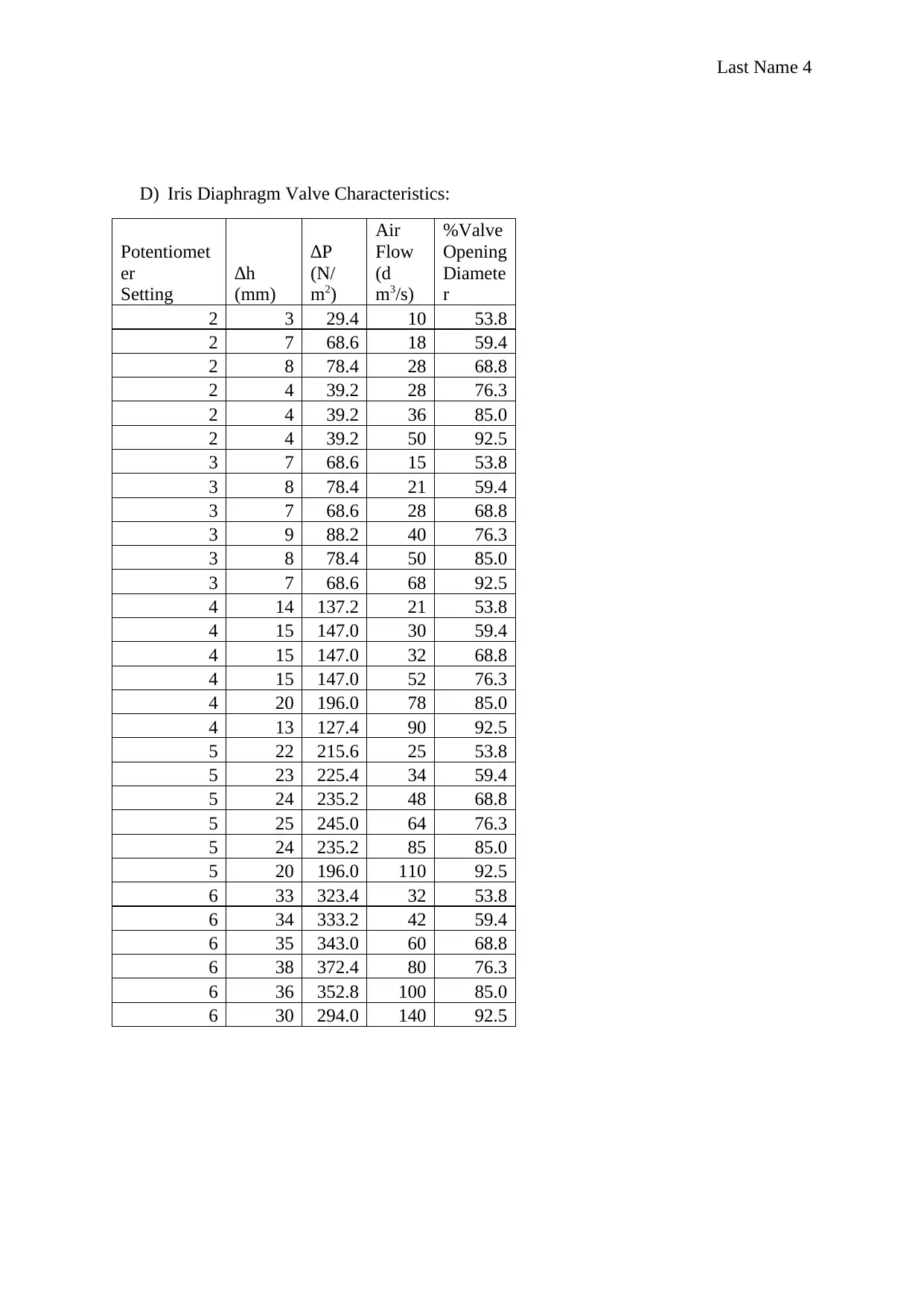
Last Name 4
D) Iris Diaphragm Valve Characteristics:
Potentiomet
er
Setting
∆h
(mm)
∆P
(N/
m2)
Air
Flow
(d
m3/s)
%Valve
Opening
Diamete
r
2 3 29.4 10 53.8
2 7 68.6 18 59.4
2 8 78.4 28 68.8
2 4 39.2 28 76.3
2 4 39.2 36 85.0
2 4 39.2 50 92.5
3 7 68.6 15 53.8
3 8 78.4 21 59.4
3 7 68.6 28 68.8
3 9 88.2 40 76.3
3 8 78.4 50 85.0
3 7 68.6 68 92.5
4 14 137.2 21 53.8
4 15 147.0 30 59.4
4 15 147.0 32 68.8
4 15 147.0 52 76.3
4 20 196.0 78 85.0
4 13 127.4 90 92.5
5 22 215.6 25 53.8
5 23 225.4 34 59.4
5 24 235.2 48 68.8
5 25 245.0 64 76.3
5 24 235.2 85 85.0
5 20 196.0 110 92.5
6 33 323.4 32 53.8
6 34 333.2 42 59.4
6 35 343.0 60 68.8
6 38 372.4 80 76.3
6 36 352.8 100 85.0
6 30 294.0 140 92.5
D) Iris Diaphragm Valve Characteristics:
Potentiomet
er
Setting
∆h
(mm)
∆P
(N/
m2)
Air
Flow
(d
m3/s)
%Valve
Opening
Diamete
r
2 3 29.4 10 53.8
2 7 68.6 18 59.4
2 8 78.4 28 68.8
2 4 39.2 28 76.3
2 4 39.2 36 85.0
2 4 39.2 50 92.5
3 7 68.6 15 53.8
3 8 78.4 21 59.4
3 7 68.6 28 68.8
3 9 88.2 40 76.3
3 8 78.4 50 85.0
3 7 68.6 68 92.5
4 14 137.2 21 53.8
4 15 147.0 30 59.4
4 15 147.0 32 68.8
4 15 147.0 52 76.3
4 20 196.0 78 85.0
4 13 127.4 90 92.5
5 22 215.6 25 53.8
5 23 225.4 34 59.4
5 24 235.2 48 68.8
5 25 245.0 64 76.3
5 24 235.2 85 85.0
5 20 196.0 110 92.5
6 33 323.4 32 53.8
6 34 333.2 42 59.4
6 35 343.0 60 68.8
6 38 372.4 80 76.3
6 36 352.8 100 85.0
6 30 294.0 140 92.5
Paraphrase This Document
Need a fresh take? Get an instant paraphrase of this document with our AI Paraphraser
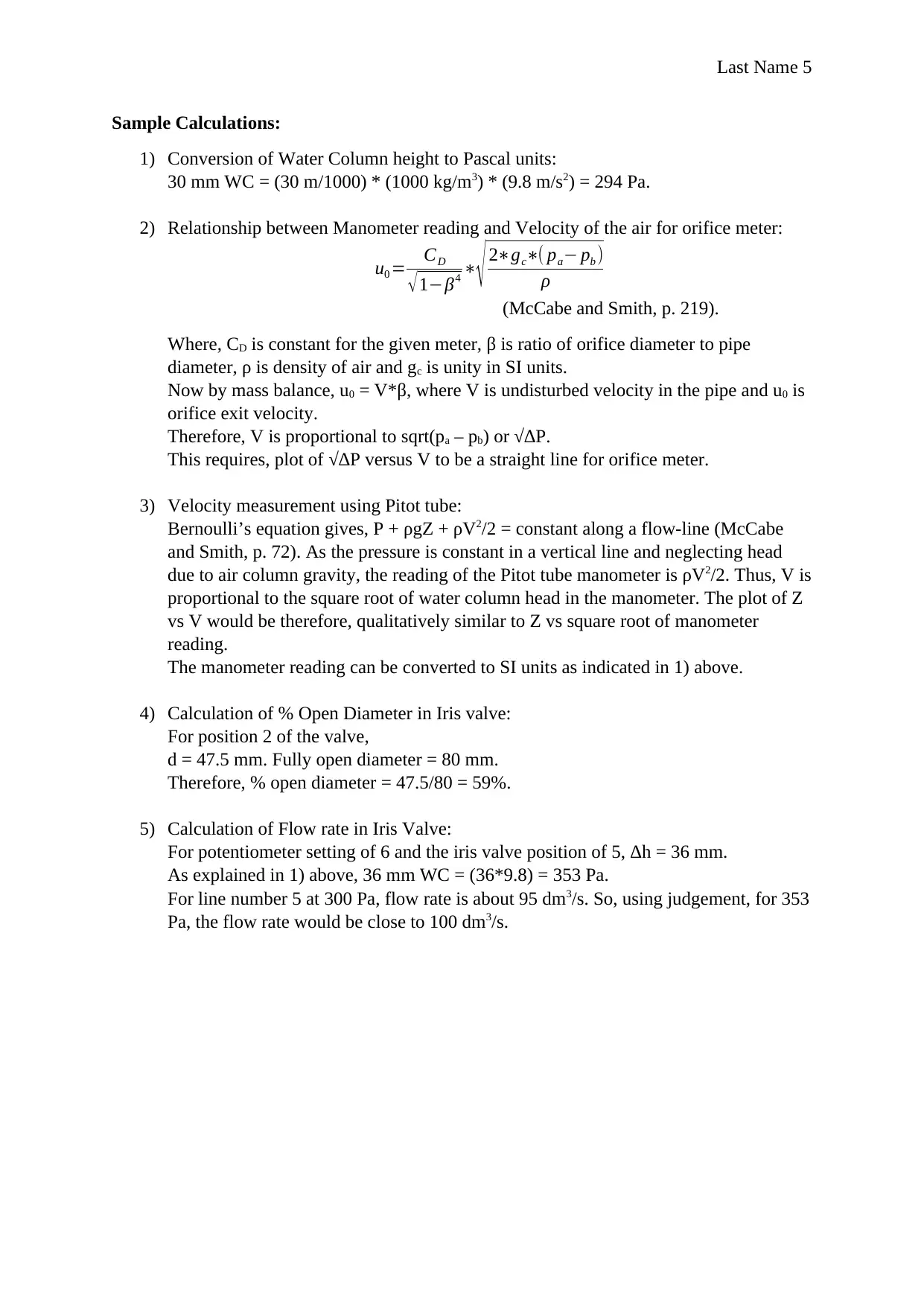
Last Name 5
Sample Calculations:
1) Conversion of Water Column height to Pascal units:
30 mm WC = (30 m/1000) * (1000 kg/m3) * (9.8 m/s2) = 294 Pa.
2) Relationship between Manometer reading and Velocity of the air for orifice meter:
u0 = CD
√1−β4 ∗
√ 2∗gc∗( pa− pb )
ρ
(McCabe and Smith, p. 219).
Where, CD is constant for the given meter, β is ratio of orifice diameter to pipe
diameter, ρ is density of air and gc is unity in SI units.
Now by mass balance, u0 = V*β, where V is undisturbed velocity in the pipe and u0 is
orifice exit velocity.
Therefore, V is proportional to sqrt(pa – pb) or √∆P.
This requires, plot of √∆P versus V to be a straight line for orifice meter.
3) Velocity measurement using Pitot tube:
Bernoulli’s equation gives, P + ρgZ + ρV2/2 = constant along a flow-line (McCabe
and Smith, p. 72). As the pressure is constant in a vertical line and neglecting head
due to air column gravity, the reading of the Pitot tube manometer is ρV2/2. Thus, V is
proportional to the square root of water column head in the manometer. The plot of Z
vs V would be therefore, qualitatively similar to Z vs square root of manometer
reading.
The manometer reading can be converted to SI units as indicated in 1) above.
4) Calculation of % Open Diameter in Iris valve:
For position 2 of the valve,
d = 47.5 mm. Fully open diameter = 80 mm.
Therefore, % open diameter = 47.5/80 = 59%.
5) Calculation of Flow rate in Iris Valve:
For potentiometer setting of 6 and the iris valve position of 5, ∆h = 36 mm.
As explained in 1) above, 36 mm WC = (36*9.8) = 353 Pa.
For line number 5 at 300 Pa, flow rate is about 95 dm3/s. So, using judgement, for 353
Pa, the flow rate would be close to 100 dm3/s.
Sample Calculations:
1) Conversion of Water Column height to Pascal units:
30 mm WC = (30 m/1000) * (1000 kg/m3) * (9.8 m/s2) = 294 Pa.
2) Relationship between Manometer reading and Velocity of the air for orifice meter:
u0 = CD
√1−β4 ∗
√ 2∗gc∗( pa− pb )
ρ
(McCabe and Smith, p. 219).
Where, CD is constant for the given meter, β is ratio of orifice diameter to pipe
diameter, ρ is density of air and gc is unity in SI units.
Now by mass balance, u0 = V*β, where V is undisturbed velocity in the pipe and u0 is
orifice exit velocity.
Therefore, V is proportional to sqrt(pa – pb) or √∆P.
This requires, plot of √∆P versus V to be a straight line for orifice meter.
3) Velocity measurement using Pitot tube:
Bernoulli’s equation gives, P + ρgZ + ρV2/2 = constant along a flow-line (McCabe
and Smith, p. 72). As the pressure is constant in a vertical line and neglecting head
due to air column gravity, the reading of the Pitot tube manometer is ρV2/2. Thus, V is
proportional to the square root of water column head in the manometer. The plot of Z
vs V would be therefore, qualitatively similar to Z vs square root of manometer
reading.
The manometer reading can be converted to SI units as indicated in 1) above.
4) Calculation of % Open Diameter in Iris valve:
For position 2 of the valve,
d = 47.5 mm. Fully open diameter = 80 mm.
Therefore, % open diameter = 47.5/80 = 59%.
5) Calculation of Flow rate in Iris Valve:
For potentiometer setting of 6 and the iris valve position of 5, ∆h = 36 mm.
As explained in 1) above, 36 mm WC = (36*9.8) = 353 Pa.
For line number 5 at 300 Pa, flow rate is about 95 dm3/s. So, using judgement, for 353
Pa, the flow rate would be close to 100 dm3/s.

Last Name 6
Graphs:
5.0 10.0 15.0 20.0 25.0 30.0
0
1
2
3
4
5
6
7
f(x) = 0.236183661084411 x
A) Nozzle Flow Characteristics
SQRT(DP in Pa)
Velocity in m/s
5.0 10.0 15.0 20.0 25.0 30.0
0
1
2
3
4
5
6
f(x) = 0.20332915291029 x
B) Orifice Plate Flow Characteristics
SQRT(DP in Pa)
Velocity in m/s
Graphs:
5.0 10.0 15.0 20.0 25.0 30.0
0
1
2
3
4
5
6
7
f(x) = 0.236183661084411 x
A) Nozzle Flow Characteristics
SQRT(DP in Pa)
Velocity in m/s
5.0 10.0 15.0 20.0 25.0 30.0
0
1
2
3
4
5
6
f(x) = 0.20332915291029 x
B) Orifice Plate Flow Characteristics
SQRT(DP in Pa)
Velocity in m/s
⊘ This is a preview!⊘
Do you want full access?
Subscribe today to unlock all pages.

Trusted by 1+ million students worldwide
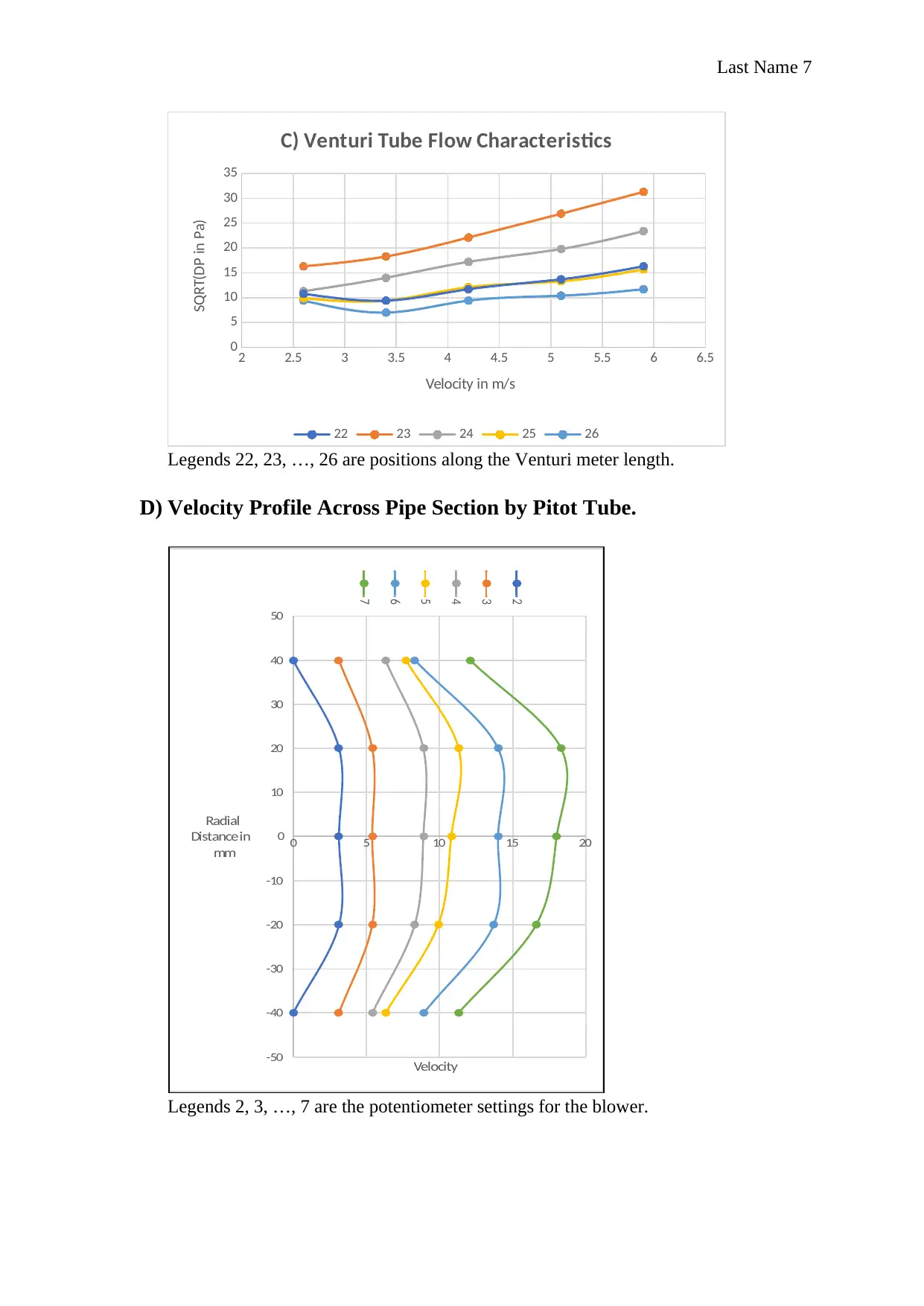
Last Name 7
2 2.5 3 3.5 4 4.5 5 5.5 6 6.5
0
5
10
15
20
25
30
35
C) Venturi Tube Flow Characteristics
22 23 24 25 26
Velocity in m/s
SQRT(DP in Pa)
Legends 22, 23, …, 26 are positions along the Venturi meter length.
D) Velocity Profile Across Pipe Section by Pitot Tube.
Legends 2, 3, …, 7 are the potentiometer settings for the blower.
0 5 10 15 20
-50
-40
-30
-20
-10
0
10
20
30
40
50
Velocity
Radial
Distance in
mm
2
3
4
5
6
7
2 2.5 3 3.5 4 4.5 5 5.5 6 6.5
0
5
10
15
20
25
30
35
C) Venturi Tube Flow Characteristics
22 23 24 25 26
Velocity in m/s
SQRT(DP in Pa)
Legends 22, 23, …, 26 are positions along the Venturi meter length.
D) Velocity Profile Across Pipe Section by Pitot Tube.
Legends 2, 3, …, 7 are the potentiometer settings for the blower.
0 5 10 15 20
-50
-40
-30
-20
-10
0
10
20
30
40
50
Velocity
Radial
Distance in
mm
2
3
4
5
6
7
Paraphrase This Document
Need a fresh take? Get an instant paraphrase of this document with our AI Paraphraser
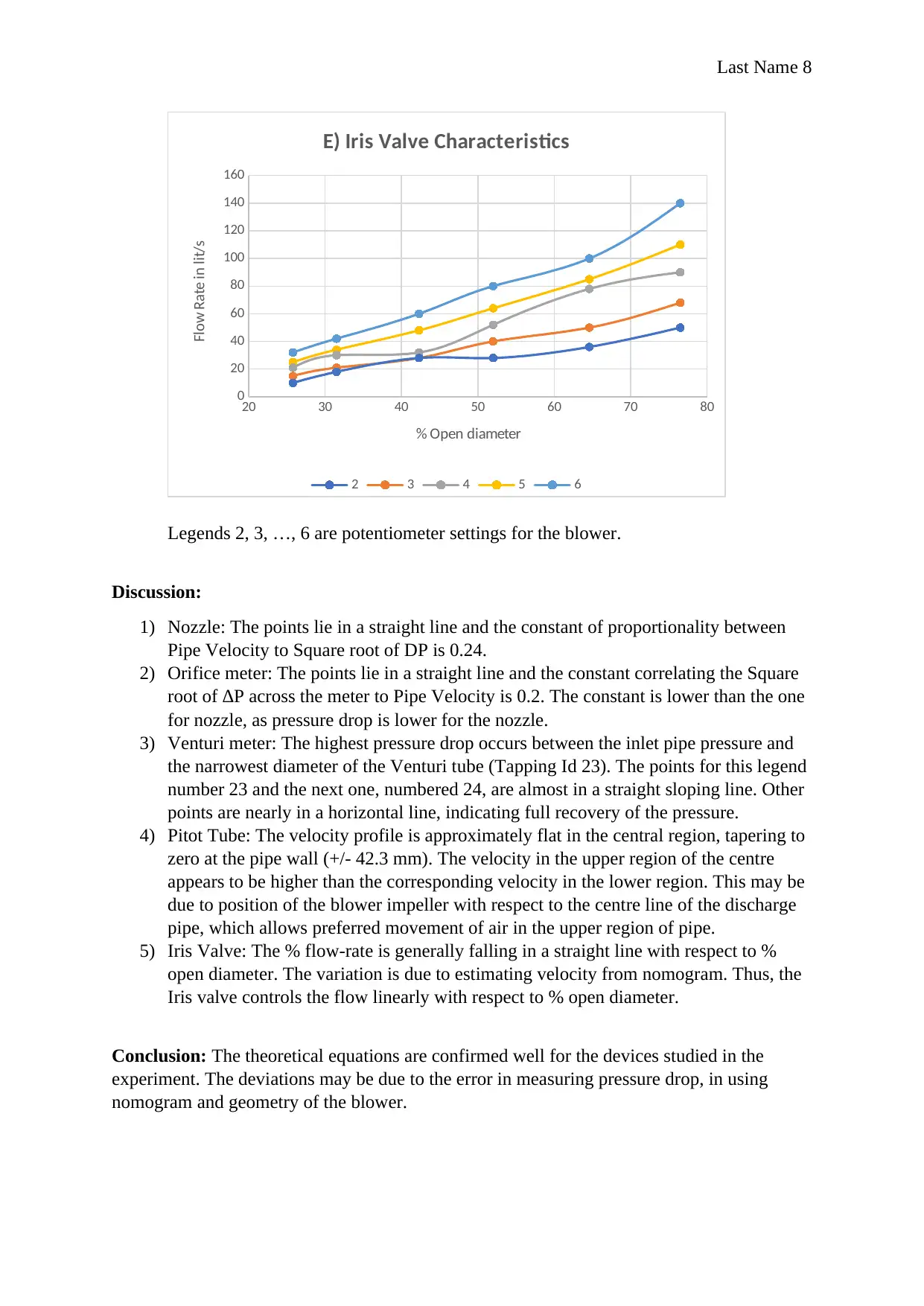
Last Name 8
20 30 40 50 60 70 80
0
20
40
60
80
100
120
140
160
E) Iris Valve Characteristics
2 3 4 5 6
% Open diameter
Flow Rate in lit/s
Legends 2, 3, …, 6 are potentiometer settings for the blower.
Discussion:
1) Nozzle: The points lie in a straight line and the constant of proportionality between
Pipe Velocity to Square root of DP is 0.24.
2) Orifice meter: The points lie in a straight line and the constant correlating the Square
root of ∆P across the meter to Pipe Velocity is 0.2. The constant is lower than the one
for nozzle, as pressure drop is lower for the nozzle.
3) Venturi meter: The highest pressure drop occurs between the inlet pipe pressure and
the narrowest diameter of the Venturi tube (Tapping Id 23). The points for this legend
number 23 and the next one, numbered 24, are almost in a straight sloping line. Other
points are nearly in a horizontal line, indicating full recovery of the pressure.
4) Pitot Tube: The velocity profile is approximately flat in the central region, tapering to
zero at the pipe wall (+/- 42.3 mm). The velocity in the upper region of the centre
appears to be higher than the corresponding velocity in the lower region. This may be
due to position of the blower impeller with respect to the centre line of the discharge
pipe, which allows preferred movement of air in the upper region of pipe.
5) Iris Valve: The % flow-rate is generally falling in a straight line with respect to %
open diameter. The variation is due to estimating velocity from nomogram. Thus, the
Iris valve controls the flow linearly with respect to % open diameter.
Conclusion: The theoretical equations are confirmed well for the devices studied in the
experiment. The deviations may be due to the error in measuring pressure drop, in using
nomogram and geometry of the blower.
20 30 40 50 60 70 80
0
20
40
60
80
100
120
140
160
E) Iris Valve Characteristics
2 3 4 5 6
% Open diameter
Flow Rate in lit/s
Legends 2, 3, …, 6 are potentiometer settings for the blower.
Discussion:
1) Nozzle: The points lie in a straight line and the constant of proportionality between
Pipe Velocity to Square root of DP is 0.24.
2) Orifice meter: The points lie in a straight line and the constant correlating the Square
root of ∆P across the meter to Pipe Velocity is 0.2. The constant is lower than the one
for nozzle, as pressure drop is lower for the nozzle.
3) Venturi meter: The highest pressure drop occurs between the inlet pipe pressure and
the narrowest diameter of the Venturi tube (Tapping Id 23). The points for this legend
number 23 and the next one, numbered 24, are almost in a straight sloping line. Other
points are nearly in a horizontal line, indicating full recovery of the pressure.
4) Pitot Tube: The velocity profile is approximately flat in the central region, tapering to
zero at the pipe wall (+/- 42.3 mm). The velocity in the upper region of the centre
appears to be higher than the corresponding velocity in the lower region. This may be
due to position of the blower impeller with respect to the centre line of the discharge
pipe, which allows preferred movement of air in the upper region of pipe.
5) Iris Valve: The % flow-rate is generally falling in a straight line with respect to %
open diameter. The variation is due to estimating velocity from nomogram. Thus, the
Iris valve controls the flow linearly with respect to % open diameter.
Conclusion: The theoretical equations are confirmed well for the devices studied in the
experiment. The deviations may be due to the error in measuring pressure drop, in using
nomogram and geometry of the blower.
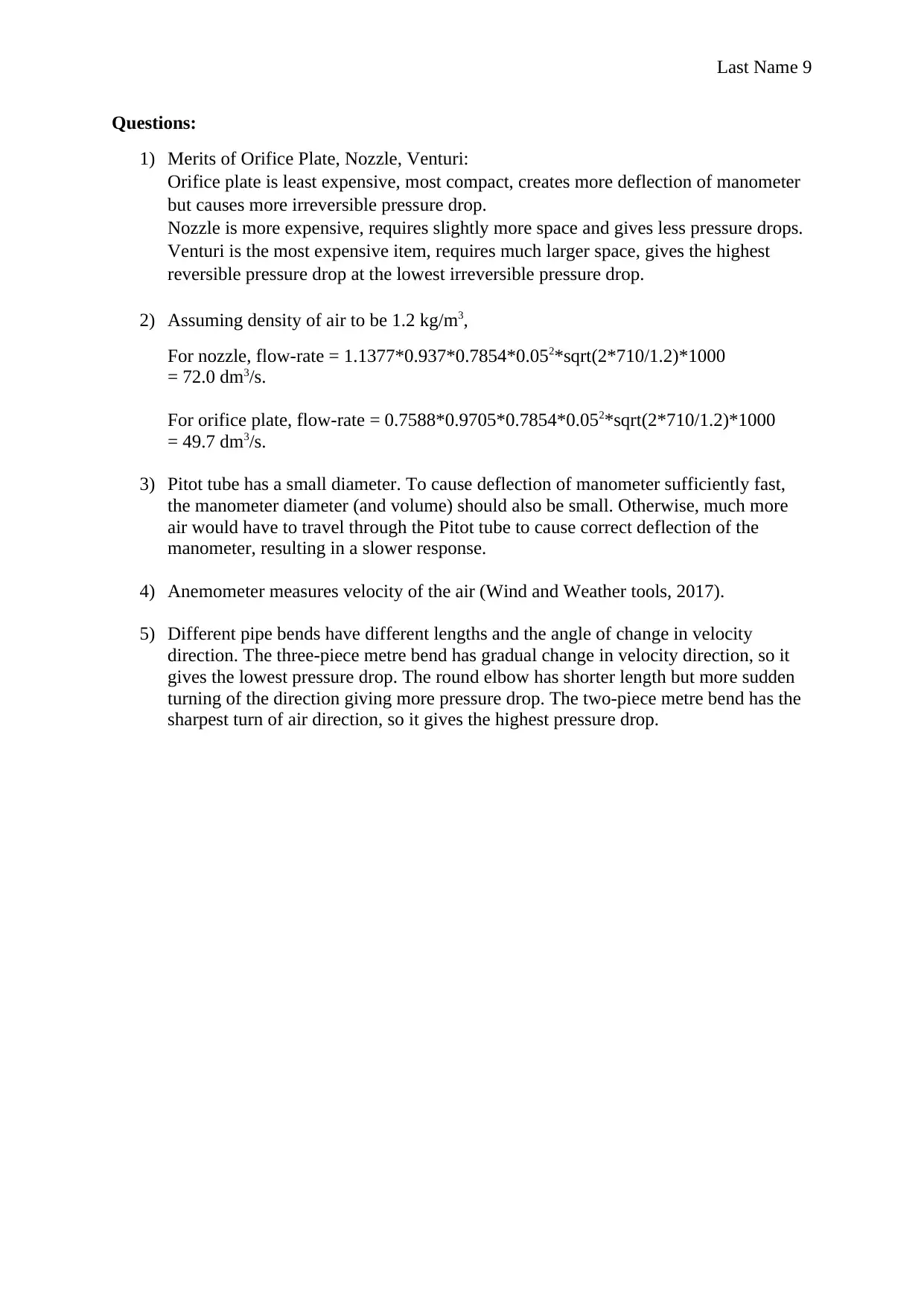
Last Name 9
Questions:
1) Merits of Orifice Plate, Nozzle, Venturi:
Orifice plate is least expensive, most compact, creates more deflection of manometer
but causes more irreversible pressure drop.
Nozzle is more expensive, requires slightly more space and gives less pressure drops.
Venturi is the most expensive item, requires much larger space, gives the highest
reversible pressure drop at the lowest irreversible pressure drop.
2) Assuming density of air to be 1.2 kg/m3,
For nozzle, flow-rate = 1.1377*0.937*0.7854*0.052*sqrt(2*710/1.2)*1000
= 72.0 dm3/s.
For orifice plate, flow-rate = 0.7588*0.9705*0.7854*0.052*sqrt(2*710/1.2)*1000
= 49.7 dm3/s.
3) Pitot tube has a small diameter. To cause deflection of manometer sufficiently fast,
the manometer diameter (and volume) should also be small. Otherwise, much more
air would have to travel through the Pitot tube to cause correct deflection of the
manometer, resulting in a slower response.
4) Anemometer measures velocity of the air (Wind and Weather tools, 2017).
5) Different pipe bends have different lengths and the angle of change in velocity
direction. The three-piece metre bend has gradual change in velocity direction, so it
gives the lowest pressure drop. The round elbow has shorter length but more sudden
turning of the direction giving more pressure drop. The two-piece metre bend has the
sharpest turn of air direction, so it gives the highest pressure drop.
Questions:
1) Merits of Orifice Plate, Nozzle, Venturi:
Orifice plate is least expensive, most compact, creates more deflection of manometer
but causes more irreversible pressure drop.
Nozzle is more expensive, requires slightly more space and gives less pressure drops.
Venturi is the most expensive item, requires much larger space, gives the highest
reversible pressure drop at the lowest irreversible pressure drop.
2) Assuming density of air to be 1.2 kg/m3,
For nozzle, flow-rate = 1.1377*0.937*0.7854*0.052*sqrt(2*710/1.2)*1000
= 72.0 dm3/s.
For orifice plate, flow-rate = 0.7588*0.9705*0.7854*0.052*sqrt(2*710/1.2)*1000
= 49.7 dm3/s.
3) Pitot tube has a small diameter. To cause deflection of manometer sufficiently fast,
the manometer diameter (and volume) should also be small. Otherwise, much more
air would have to travel through the Pitot tube to cause correct deflection of the
manometer, resulting in a slower response.
4) Anemometer measures velocity of the air (Wind and Weather tools, 2017).
5) Different pipe bends have different lengths and the angle of change in velocity
direction. The three-piece metre bend has gradual change in velocity direction, so it
gives the lowest pressure drop. The round elbow has shorter length but more sudden
turning of the direction giving more pressure drop. The two-piece metre bend has the
sharpest turn of air direction, so it gives the highest pressure drop.
⊘ This is a preview!⊘
Do you want full access?
Subscribe today to unlock all pages.

Trusted by 1+ million students worldwide

Last Name 10
References
1) McCabe, W., J. Smith and P. Harriot (1993). Unit Operations of Chemical
Engineering, 5th edition, London: McGraw-Hill.
2) Wind and Weather Tools (2017). What is an Anemometer and What It is Used for,
https://windandweathertools.com/what-is-an-anemometer-and-what-is-it-used-
for/, Accessed on 30th December 2017.
References
1) McCabe, W., J. Smith and P. Harriot (1993). Unit Operations of Chemical
Engineering, 5th edition, London: McGraw-Hill.
2) Wind and Weather Tools (2017). What is an Anemometer and What It is Used for,
https://windandweathertools.com/what-is-an-anemometer-and-what-is-it-used-
for/, Accessed on 30th December 2017.
1 out of 10
Related Documents
Your All-in-One AI-Powered Toolkit for Academic Success.
+13062052269
info@desklib.com
Available 24*7 on WhatsApp / Email
![[object Object]](/_next/static/media/star-bottom.7253800d.svg)
Unlock your academic potential
Copyright © 2020–2025 A2Z Services. All Rights Reserved. Developed and managed by ZUCOL.



